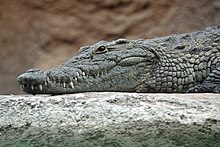Diapsid
| Diapsid reptiles | |
|---|---|

| |
| Skull diagram of the Petrolacosaurus kansensis
| |

| |
| Nile crocodile (Crocodylus niloticus) | |
| Scientific classification | |
| Domain: | Eukaryota |
| Kingdom: | Animalia |
| Phylum: | Chordata |
| Class: | Reptilia |
| Clade: | Romeriida
|
| Clade: | Diapsida Osborn, 1903 |
| Subgroups | |
Diapsids ("two arches") are a clade of
Characteristics
The name Diapsida means "two arches", and diapsids are traditionally classified based on their two ancestral skull openings (
Classification
Diapsids were originally classified as one of four subclasses of the class
Some modern studies of reptile relationships have preferred to use the name "diapsid" to refer to the crown group of all modern diapsid reptiles but not their extinct relatives. However, many researchers have also favored a more traditional definition that includes the prehistoric araeoscelidians. In 1991, Laurin defined Diapsida as a clade, "the most recent common ancestor of araeoscelidians, lepidosaurs, and archosaurs, and all its descendants".[5]
A cladistic analysis by Laurin and Piñeiro (2017) recovers
Relationships
Below is a cladogram showing the relations of the major groups of diapsids.
Cladogram after Bickelmann et al., 2009[8] and Reisz et al., 2011:[9]
| ||||||||||||||||||||||
See also
References
- ^ "Those diverse diapsids".
- PMID 26934902.
- PMID 27880775.
- PMID 25803280.
- ^ Benton, M. J., Donoghue, P. C., Asher, R. J., Friedman, M., Near, T. J., & Vinther, J. (2015). "Constraints on the timescale of animal evolutionary history." Palaeontologia Electronica, 18.1.1FC; 1-106; palaeo-electronica.org/content/fc-1
- S2CID 32426159.
- S2CID 209673326.
- doi:10.1139/E09-038.
- PMID 21525061.







